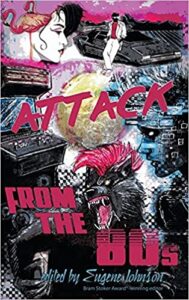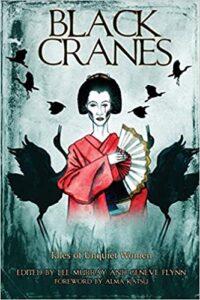Attack From the ’80s edited by Eugene Johnson
Raw Dog Screaming Press, 2021
ISBN-13: 978-1735664446
Available: Hardcover ( Bookshop.org | Amazon.com )
Eugene Johnson brings together 22 incredible short stories and poems as a fitting tribute to the horror of the 1980s. There is something for everyone in this collection. “Top Guns of the Frontier” by Weston Ochse, a strong open to this anthology, tells the story of friends coming face to face with an ancient evil. In “Snapshot” by Joe R. Lansdale and Kasey Lansdale, Gracie and Trevor, the famous Snapshot Burglars, rob the wrong house. Jess Landry’s “Catastrophe Queens” takes place on the movie set of an ’80s SS werewolf horror film. Pink fake blood starts to take over people…and anything it touches. In “Your Picture Here” by John Skipp, a couple decides to take in a double feature of horror movies only to discover one of the films is closer to the truth. Lee Murray’s “Permanent Damage” invites us to a bridal party at a salon that turns into a bloodbath. “Munchies” by Lucy A. Snyder is a great story about a group of drag queens and the terror that was Nancy Reagan who has come to deliver a check to the local high school’s antidrug drive.
No ’80s horror anthology would be complete without the topic of D&D. In “Demonic Denizens” by Cullen Bunn, friends at summer camp discover a new game to play after the counselors forbid them to play any more of that “satanic” Dungeons & Dragons. “Ghetto Blaster”, by Jeff Strand, presents Clyde, who is cursed to carry a rather heavy ghetto blaster until he learns his lesson about loud music in public spaces. Everyone, check your candy before reading “Stranger Danger” by Grady Hendrix. A group of boys, hell-bent on taking revenge on the Judge, discover an army of Yoda-costumed children who have their own havoc to create, with apples containing razor blades the treat of the night. In Lisa Morton’s “The Garden of Dr. Moreau”, a biology experiment on corn plants is a success, but it could be at a deadly cost for life on Earth.
Other authors in the anthology include Ben Monroe, Linda Addison, Thomas F. Monteleone, Tim Waggoner, Stephen Graham Jones, Vince A. Liaguno, Rena Mason, Cindy O’Quinn, F. Paul Wilson, Christina Sng, Mort Castle, and Stephanie M. Wytovich. Pick this up if you need a good dose of 80s horror reading. Highly recommended.
Reviewed by Lizzy Walker






Follow Us!